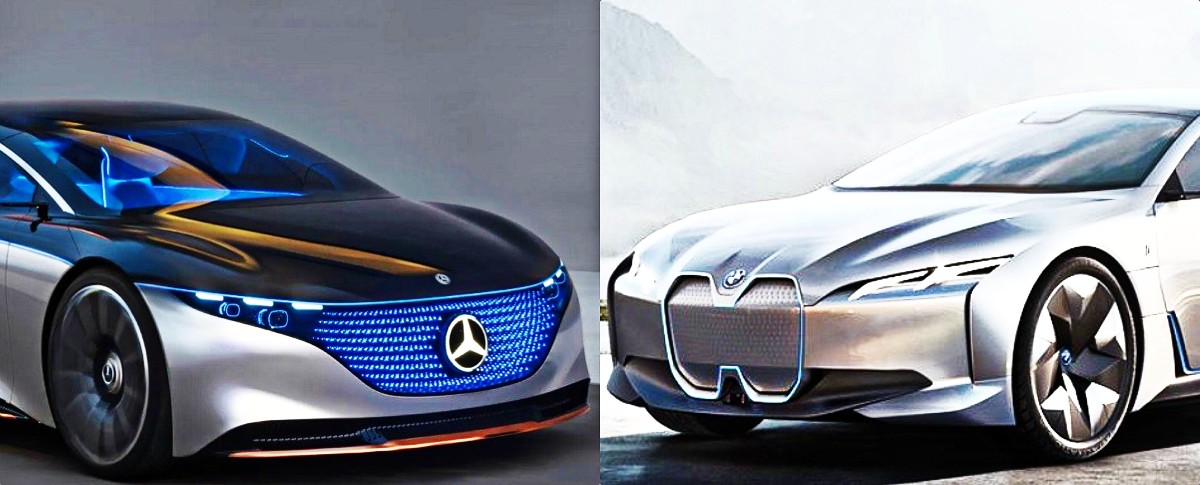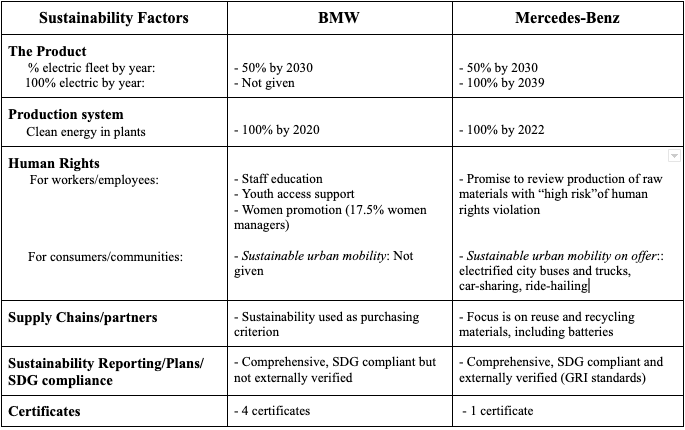Headlines trumpet the news when BMW beats Mercedes and vice-versa in the race for the world’s top luxury car – the two German carmakers tend to be first, ahead of their conational Audi. In 2020, the crown went to Mercedes on a global level but BMW won in the United States. But what about another kind of news, which one is better at going green? Which has adopted the more sustainable methods of production and is more socially responsible?
The race to be the most luxurious car in the world is, of course, what attracts the most attention. And it’s always a close, exciting race. On February 11, 2021, BMW claimed the top spot (by value) for U.S. automotive exports for the 7th year in a row, despite the production interruption in the spring of 2020 caused by COVID-19 lockdown. The same day, in the race for the best German-made three-row luxury SUV, Motor Trend, in a test reviewing Mercedes-Benz GLS580 vs. BMW X7, picked the Mercedes model over BMW.
And both are coming out with exciting electric models because as we now know, the automotive future is inevitably electric.
For those who doubt it, it’s enough to watch this video recently filmed in a Mercedes electric car plant in Germany to remained convinced that our future is not only electric but fully robotized:
It takes five minutes into the video before a human appears – wearing a mask, of course, in deference to the pandemic. And the robots, covered in cloth, take on the looks of alarming ghosts. But the video makes the point that Mercedes is determined to get technologically ahead of everyone.
In the race for the best electric car, however, BMW is not far behind:
But Mercedes has its own visionary response, check out the Vision EQS (top of the EQ range), with holographic headlights, truly futuristic:
The “Vision” is Mercedes Benz’s exciting idea of “sustainable modern luxury”, which is, if you listen to the enthusiastic Mercedes engineer in that video, is precisely what the company stands for: A car that is (1) efficient, (2) electric, and (3) uses recycled materials, in short, a “fully recyclable car”.
That sounds nice but I have, of course, a lingering doubt regarding this and all-electric car models: How sustainable are they if the electricity they use is made from fossil fuels? But how an energy grid is powered is not, arguably, the direct responsibility of carmakers. Still, they arguably have some responsibility: How they contribute to the general demand for electricity through the production of electric cars does matter. Carmakers, in principle, could make a difference in society, if they would all agree to stop producing gas-guzzlers and diesel polluters.
Pouring money into electric car battery research could change the game. But it’s still too early to tell how fruitful such investments will be. But big efforts are underway. For example, to avoid becoming dependent on Asian suppliers and to preserve auto industry jobs in Europe, the European Commission, last month, announced a €2.9 billion ($3.5 billion) fund to support battery manufacturing and research.
So where do BMW and Mercedes stand in the race to sustainability?
To get an answer, I turned to the Impakter Sustainability Index, taking advantage of the deep digging the Impakter Index team did to unearth the reality of both carmakers’ claims to have green plans. And to be moving fast towards sustainability in production and social responsibility vis-a-vis all stakeholders.
The answer may come as a surprise for some, it certainly surprised me. They are not doing as well as expected, not by a long shot. To sum up: I expected BMW, in particular, to do better than that since it’s supposed to produce the high-performance car par excellence. Could it be that it’s not “high-performance” when it comes to sustainability?
I expected BMW, in particular, to do better than that since it’s supposed to produce the high-performance car par excellence. Could it be that it’s not “high-performance” when it comes to sustainability?
As shown on the Impakter Index, the two brands picked a very different path to sustainability, aiming for different sets of Sustainable Development Goals (SDGs) – except for one on which they agree, SDG#12: “responsible consumption and production”.
A closer look at the differences in the chosen path to sustainability reveals a substantial difference in emphasis.
The SDGs picked by BMW are more “social” – focused on education and equality, something they have certainly spent money and efforts on, educating staff, focusing on the young and opening the doors to management for women. A reported 17.5% of women are in management and that’s a remarkably high ratio (apparently not matched by Mercedes).
By contrast, the SDGs picked by Mercedes are more “technical” and dictated by the kind of products they offer. Thus Mercedes includes SDG#11 (“sustainable cities”) because it produces electric buses, a major component of sustainable urban mobility – a kind of vehicle that is not produced by BMW whose focus is on passenger cars:
Both brands gathered in the process different sustainability certificates, 4 for BMW and just one for Mercedes. Albeit that is one they share, the ISO14001 standard that sets out criteria for environmental management.
This said, despite promises and plans to go green and turn electric, neither are doing well – for now. Clearly, they have a long way to go before becoming wholly sustainable and fully socially responsible.
If you think a “C” rating is too harsh, consider how long they plan to take just to achieve a basic sustainability objective in the car industry, a fully electric vehicle: Nine years to reach half-way. They both promise their fleet will be 50% electric by 2030.
Worse, Mercedes admits to having spent €3 billion to develop a “new generation” of diesel engines. That is a big step backward. In fact, Mercedes plans to stop producing petrol and diesel cars only by 2039: that’s some 20 years away.
Compare that to Tesla or Rivian which are fully electric from the get-go, two of the stars in the set of “electric dream cars” I recently reported on – dream cars that are already here.
Consider also that there are more factors behind the “C” rating than just a slow approach to electrification. Here are all the factors uncovered by the Impakter Index analysis that need to be considered in setting up the rating and how well each brand addresses them:
As the above table shows, the performance of each, while they are both good in terms of clean energy use in plants (especially in their European plants), is nuanced by variable achievements on other chapters.
Mercedes is stronger in sustainability reporting since it follows the scientific and externally verified GRI standards while BMW has been better at obtaining certificates. Performance in human rights is also variable and there are obvious areas in which each one could improve and learn from the other, particularly in human rights, recycling and sustainable urban mobility.
In short, the road to sustainability is likely to be a long, hard one for both brands, but they have started on it and that’s a good thing. The outlook is positive, and with a little effort, they could soon climb into the “B” category – while “A” will have to wait until they are fully sustainable.
Editor’s Note: The opinions expressed here by Impakter.com columnists are their own, not those of Impakter.com. — Featured image: Mercedes-Benz vs. BMW electric vehicles 2021 (photomontage)










